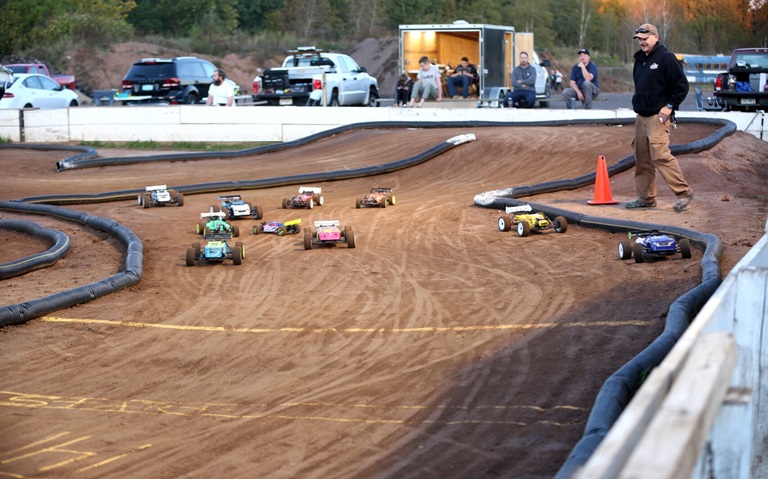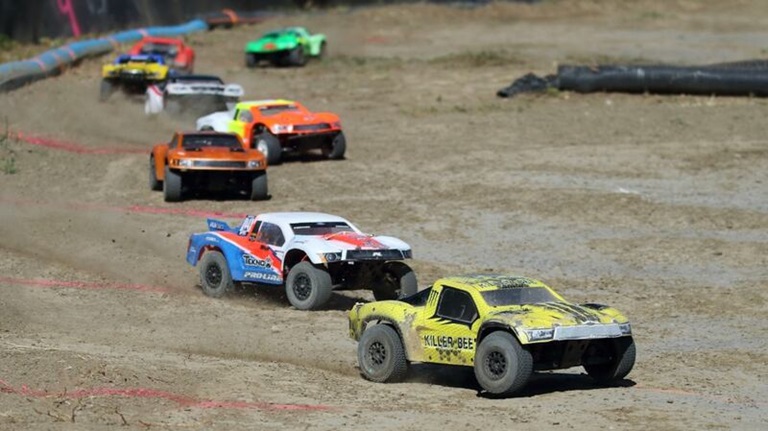Contents
New to radio-controlled cars, but are bewildered by the sheer variety? Just like regular vehicles, RC cars are scaled-down versions of the real thing. They’re customisable, brimming with performance and most importantly, fun. On the plus side, crashes won’t hurt anybody and don’t cost anywhere near as much to repair.
Deciding Between the Different Types

If you want the excitement and thrills that come with a fully kitted radio-controlled car, consider where and how you’ll be using your new wheels. The general divide in hobby RC cars is between on and off-road vehicles, leading to different shapes, sizes and capabilities. Let’s take a closer look at what’s on offer:
On-road RC Cars
If speed, maneuverability, and control are your main priorities, go with on-road RC cars. These are designed from smoother surfaces such as tarmac, concrete and indoor tracks, ensuring crisp steering, lightning-fast acceleration and benefit from realism in terms of scale and details.
If you can’t afford that Lambo or drooled over a tuned Toyota Supra as a kid, on-road RC replicas are the next best thing. Bodyshells, chassis, suspension setups and engines are all reminiscent of the cars they replicate, with wheels and tyres (down to tread types) almost a carbon copy of the real car.
Common options (regardless of skill level) include:
- Touring RC cars: Providing the perfect balance between performance and accessibility, touring cars come in 1/8, 1/10 (most common) and 1/12 scale, include 2WD and 4WD drivetrains, and brushless motors for lasting speed and efficiency. They’re good for all skill levels, but beginners in particular, with predictable steering and a generous grip on various surfaces.
- F1 cars: With suspension setups stripped straight out of the real thing, F1 RC cars also include instant throttle response, tight steering and ball differentials to mimic the downforce and cornering agility of real F1 cars. And like real F1 cars, they do need more skill.
- Drift cars: Rear-wheel drivetrains, increased wheel caster for supple steering, and high-torque front-mounted motors with instant power delivery make drift RC vehicles a fan favourite.
- Drag cars: For competition drag racing and straight-line fun, choose a drag RC car. Speeds of over 100km/h aren’t uncommon.
Off-road RC Cars
For a more versatile option on a variety of surfaces, go with off-road RC cars. These are good for grass, rocks and mud, come with more durable chassis able to withstand knocks and jumps, and souped-up suspension setups able to take the impact and keep wheels rolling.
Most of these hobby RC cars are fitted with capable 4WD drivetrains to split power and torque between front and rear wheels when negotiating tougher terrain. And since they see more than their fair share of abuse, off-road RC vehicles also feature sealed electronics to shield engines and controls from water and dirt ingress.
Compared to on-road vehicles, RC cars with off-roading in mind come in more distinct designs, often eliminating the need for realism. Choose from the following to get your off-roading thrills:
- Buggies: Perennial favourites for all skill levels and age groups, buggies mix the agility and speed of on-road cars with a lightweight but durable chassis riding on long-travel suspension and off-road tyres. Despite their lower ground clearance, they’re good for everyday use, especially in fast runs and jumps.
- Short-course trucks: These combine speed, the scale realism of real trucks, and the ability to perform equally well both on and off-road. They’re durable, fitted with high-power brushless motors and capable suspension for versatile performance.
- Rock crawlers: If you want something that can go anywhere, then get a rock crawler. These sacrifice top speeds for outright handling ability and traction over extreme obstacles. Paired with precision steering, extras like locking diffs and realistic details like working winches, they’re the RC cars for true off-roading enthusiasts.
- Monster trucks: Who doesn’t like monster trucks? RC versions are fitted with raised chassis, outsized off-road tyres, heavy-duty suspension and huge ground clearance for going just about anywhere at speed.
What to Look for

Now that you’ve chosen the right type of vehicle, consider all other buying factors.
Skill Levels
Anyone just dipping their toes in the wide RC realm is advised to look to ready-to-run (RTR) cars. These are pre-assembled, usually with front or rear 2WD drivetrains and simple controls. They’re small, straightforward, affordable and loaded with fun. Run times, maneuverability or top speeds might be worlds away from more expensive vehicles, but RTR cars are a sure way to get anyone hooked.
Once you’re settled in, move on to cars requiring intermediate skills. This may need some assembly work, but it also allows more customisation options, such as choosing between different batteries, motors and minor bodywork details. There’s also more effort in general driving and handling.
Advanced skill sets assume you know what you’re doing. Cars here can be built from the ground up (much like real vehicle and engine rebuilds), with models requiring more detailed setup and basic maintenance knowledge. Models sold in this skill set are also considerably faster, more customisable and require higher driving control. Expert levels are reserved for RC veterans, often with sizeable cars running on nitro engines, or multiple LiPO batteries and with extreme speeds and handling. Each skill set roughly corresponds with RC car scale and price.
Scale
Scale indicates size relative to a real vehicle. For most on and off-road cars, you’ll generally be looking at RC vehicles in 1/10 scale, but bigger 1/8 and smaller 1/12 cars are also sold. Cheaper 1/24 vehicles are mostly reserved for RTR vehicles.
Pricing and Brands
There’s tough competition in the RC world, with dozens of brands vying for the top spot. Traxxas is known for its RTR and beginner kits, Tamiya is praised among builders and replica enthusiasts, Axial does well with rock crawlers, while HPI Racing and Losi are respected for their off-road performance vehicles. Prices are affordable for entry-level RTR kits for beginners, but can reach the low 4 figures in fully-optioned, competition builds.

